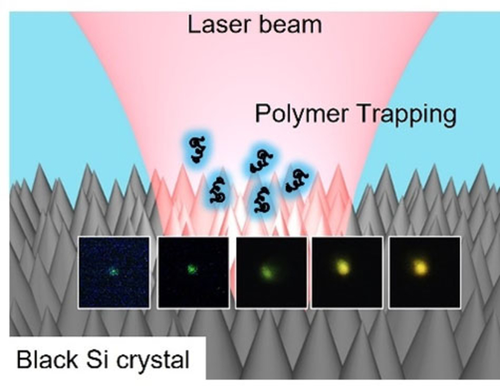
[NASSCA光ピンセットを用いた光圧による蛍光変調]
Hot Paperに選出されました。
大阪市立大学との共同プレスリリースを発表しました。
NASSCA光ピンセットにより蛍光性高分子鎖の光捕捉に成功し、さらに捕捉分子からの蛍光色を光圧により制御できることを見出しました。
坪井教授(大阪市立大学)、Ivanova教授(豪・ロイヤルメルボルン工科大学)、Juodkazis教授(豪・スウィンバーン工科大学)らのグループとの共同研究の成果です。
- 研究成果のポイント
- エキシマー蛍光を示すペリレン分子で化学修飾した水溶性高分子 ポリ(N,N-ジメチルアクリルアミド)(perylene-PDMA)を、ナノ構造を付与したケイ素基板(ブラックシリコン)上で光捕捉することに成功
- 近赤外レーザー光強度の増加とともに、蛍光強度の増加(捕捉分子数の増加)とペリレンのエキシマー発光を観測。
- 青色発光から橙色発光への蛍光変調を光圧により制御することに成功
- Fluorescence Colour Control in Perylene-Labeled Polymer Chains Trapped by Nanotextured Silicon
- Ryota Takao, Kenta Ushiro, Hazuki Kusano, Ken-ichi Yuyama, Tatsuya Shoji, Denver P. Linklater, Elena Ivanova, Saulius Juodkazis, Yasuyuki Tsuboi*
- Angew. Chem. Int. Ed., 61 (2022), e202117227.
- DOI: 10.1002/anie.202117227
The ability to modulate, tune, and control fluorescence colour has attracted much attention in photonics-related research fields. Thus far, it has been impossible to achieve fluorescence colour control (FCC) for material with a fixed structure, size, surrounding medium, and concentration. Here, we propose a novel approach to FCC using optical tweezers. We demonstrate an optical trapping technique using nanotextured Si (black-Si) that can efficiently trap polymer chains. By increasing the laser intensity, the local concentration of perylene-labelled water-soluble polymer chains increased inside the trapping potential. Accordingly, the excimer fluorescence of perylene increased while the monomer fluorescence decreased, evidenced by a fluorescence colour change from blue to orange. Using nanostructure-assisted optical tweezing, we demonstrate control of the relative intensity ratio of fluorescence of the two fluorophores, thus showing remote and reversible FCC of the polymer assembly. An optical tweezer technique using nanotextured Si (black-Si) can efficiently trap polymer chains. By increasing the laser intensity, the local concentration of perylene-labelled water-soluble polymer chains increased inside the trapping potential. Accordingly, the excimer fluorescence of perylene increased while the monomer fluorescence decreased. Based on the behaviour, we can control the fluorescence colour; blue, green, yellow-green, yellow, and orange.
https://onlinelibrary.wiley.com/doi/10.1002/anie.202117227